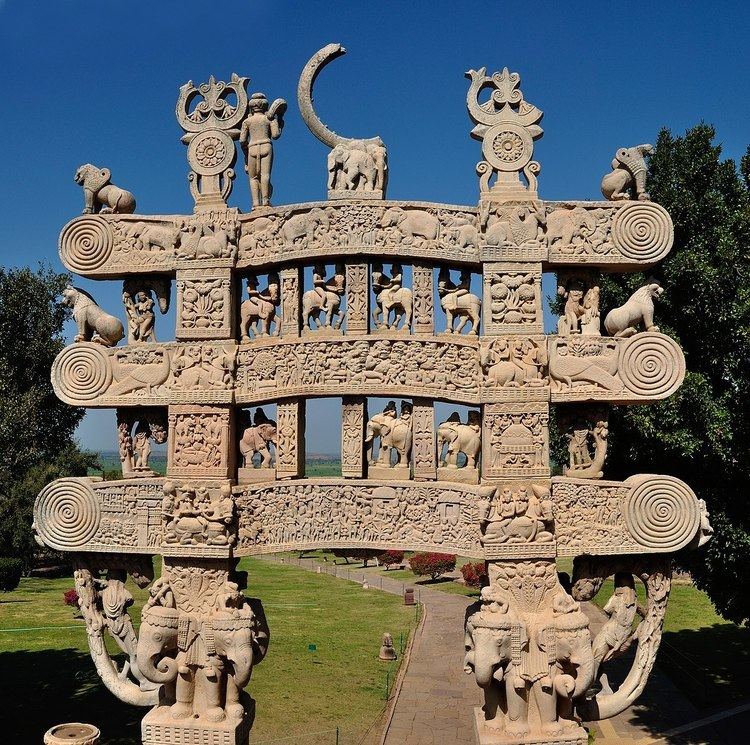 | ||
Bharata Khanda (or Bharata Ksetra) is a term used in Hindu texts, including the Vedas, Mahabharata, Ramayana and the Puranic, to describe the geographic region that encompassed the modern countries of Afghanistan, Bangladesh, India, Pakistan, Nepal, Bhutan, Sri Lanka and Brahmadesh. The historical context of the Sanskrit epics are the Vedic period (1700-600 BC), Mahajanapadas (600 BC) and the subsequent formation of the Maurya Empire (322 BCE), the beginning of the "golden age" of Classical Sanskrit literature.
Contents
The name
In Hindu scriptures, Bharata Khanda is habitable world; the known land as experienced by the writers.
The boundaries of the kingdoms
Often rivers formed the boundaries of two neighboring kingdoms, as was the case between the northern and southern Panchala and between the western (Pandava's Kingdom) and eastern (Kaurava's Kingdom) Kuru. Sometimes, large forests, which were larger than the kingdoms themselves, formed their boundaries as was the case of the Naimisha Forest between Panchala and Kosala kingdoms. Mountain ranges like Himalaya, Vindhya and Sahya also formed their boundaries.
The cities and villages
Some kingdoms possessed a main city that served as its capital. For example, the capital of Pandava's Kingdom was Indraprastha and the Kaurava's Kingdom was Hastinapura. Ahichatra was the capital of Northern Panchala whereas Kampilya was the capital of Southern Panchala. Kosala Kingdom had its capital as Ayodhya. Apart from the main city or capital, where the palace of the ruling king was situated, there were small towns and villages spread in a kingdom. Tax was collected by the officers appointed by the king from these villages and towns. What the king offered in return to these villages and towns was protection from the attack of other kings and robber tribes, as well as from invading foreign nomadic tribes. The king also enforced code and order in his kingdom by punishing the guilty.
Interactions between kingdoms
There was no border security for a kingdom and border disputes were very rare. One king might conduct a military campaign (often designated as Digvijaya meaning victory over all the directions) and defeat another king in a battle, lasting for a day. The defeated king would acknowledge the supremacy of the victorious king. The defeated king might sometimes be asked to give a tribute to the victorious king. Such tribute would be collected only once, not on a periodic basis. The defeated king, in most cases, would be free to rule his own kingdom, without maintaining any contact with the victorious king. There was no annexation of one kingdom by another. Often a military general conducted these campaigns on behalf of his king. A military campaign and tribute collection was often associated with a great sacrifice (like Rajasuya or Ashvamedha) conducted in the kingdom of the campaigning king. The defeated king also was invited to attend these sacrifice ceremonies, as a friend and ally.
New kingdoms
New kingdoms were formed when a major clan produced more than one King in a generation. The Kuru (kingdom) clan of Kings was very successful in governing throughout North India with their numerous kingdoms, which were formed after each successive generation. Similarly, the Yadava clan of kings formed numerous kingdoms in Central India.
Cultural differences in the kingdoms
Western parts of India were dominated by tribes who had a slightly different culture that was considered as non-Vedic by the mainstream Vedic culture prevailed in the Kuru and Panchala kingdoms. Similarly there were some tribes in the eastern regions of India, considered to be in this category. Tribes with non-Vedic culture specially those of barbaric nature were collectively termed as Mlechha. Very little was mentioned in the ancient Indian literature, about the kingdoms to the North, beyond the Himalayas. China was mentioned as a kingdom known as Cina, often grouped with Mlechcha kingdoms.
Kingdoms of the Himalayas
The table lands and valleys of the great Himalayan Mountain Ranges, which were almost inaccessible to the people settled in the Ganges, Sarasvati River and Sindhu river valleys, were inhabited by tribes who had very little interactions with the rest of the world. The domains of these tribes are listed below:
To know about the mythological aspects of these exotic tribes see Hindu mythology. To know about the historical significance of these tribes see the Exotic tribes of ancient India.
